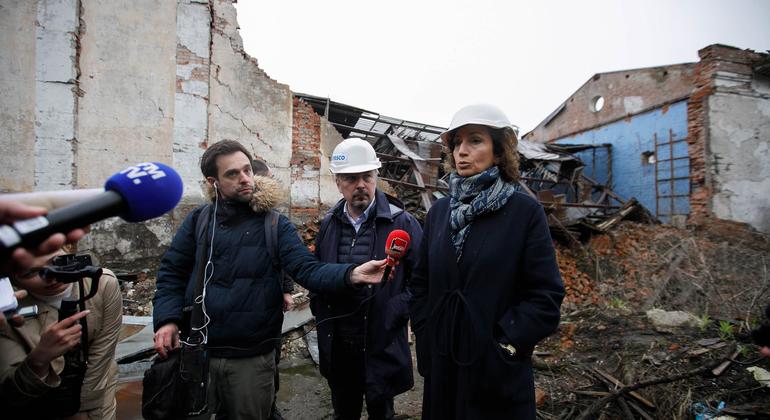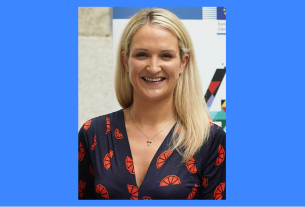UNESCO Director-General Audrey Azoulay was in Ukraine to reaffirm support to the population amid the continuing full-scale Russian invasion, which began on 24 February last year.
She visited the capital, Kyiv, and the cities of Odessa and Chernihiv, during the two-day mission, which concluded on Wednesday.
Pillar of peace
“Since the very first days of the war, UNESCO has stood by the Ukrainian people to help protect culture, heritage, education and the safety of journalists. These are the pillars of our humanity, of our identities; the pillars of the country’s recovery and of peace,” she said, speaking at a press briefing outside Saint Sophia Cathedral in Kyiv, a UNESCO World Heritage Site.
Throughout the conflict, where Russia has frequently targeted civilian areas, UNESCO has reiterated that the targeting of cultural sites and schools violates international law.
UNESCO Director-General Audrey Azoulay (2nd left) visits a church in Ukraine.
Protection and support
The agency has also deployed a $30 million emergency plan in Ukraine which ranges from protective equipment for monuments and works of art, to the distribution of more than 50,000 computers so that teachers can continue remote education, to the provision of dozens of helmets and bullet-proof vests to journalists working in combat zones.
“This support will continue and increase in 2023,” Ms. Azoulay announced during a meeting with teachers in a school in Chernihiv.
She said that in the coming weeks, UNESCO is mobilizing more than $10 million in additional funding to respond to the education emergency, noting that strengthening of psychosocial support for students is a priority.
Culture recovery plan
Ms. Azoulay also presented figures on the impact of the war on all areas of culture over the past year, including some $2.6 billion in physical damage.
“In order to rebuild but also to redress the situation, it will be necessary to invest $6.9 billion in the cultural sector in Ukraine over the next 10 years,” she said on the sidelines of a working meeting with President Volodymyr Zelenskyy.

UNESCO Director-General Audrey Azoulay (centre left) meets President Volodymyr Zelenskyy during her mission to Ukraine.
At the meeting, the President welcomed measures already implemented by the UN agency. “Sometimes there are only words. With UNESCO, there are concrete results,” he said.
Mr. Zelenskyy requested UNESCO to support the Government’s development of a recovery plan for the cultural sector, while continuing to coordinate and mobilize international partners.
Preserving Odesa’s heritage
Ms. Azoulay concluded her visit in the port city of Odesa, whose historic centre was inscribed by UNESCO on the List of World Heritage in Danger in late January.
The UN agency will further strengthen actions on the ground, with priority given to preserving and digitizing artistic and documentary heritage while maintaining the protection of historic buildings endangered by artillery fire.
UNESCO will also launch a project to improve the conservation of the city’s archaeological museum collections through financial support from the foundation of its Goodwill Ambassador Marc Ladreit de Lacharrière, Founder and President of French holding company FIMALAC.
Energy sector damage exceeds $10 billion
Relatedly, damage to Ukraine’s power, gas and heating infrastructure exceeds $10 billion, according to an assessment published on Wednesday by the UN Development Programme (UNDP) and the World Bank.
Attacks have left over 12 million people with limited or no electricity, while also disrupting water supply and heating systems.
It’s estimated that necessary emergency repairs will come with a $1.2 billion price tag.
“Right now, the priority is to keep the lights on and the heat flowing,” said Jaco Cilliers, UNDP Resident Representative in Ukraine.
He added that a key focus will be to secure power supply for critical infrastructure in big cities and in war-affected areas damaged beyond recovery.



